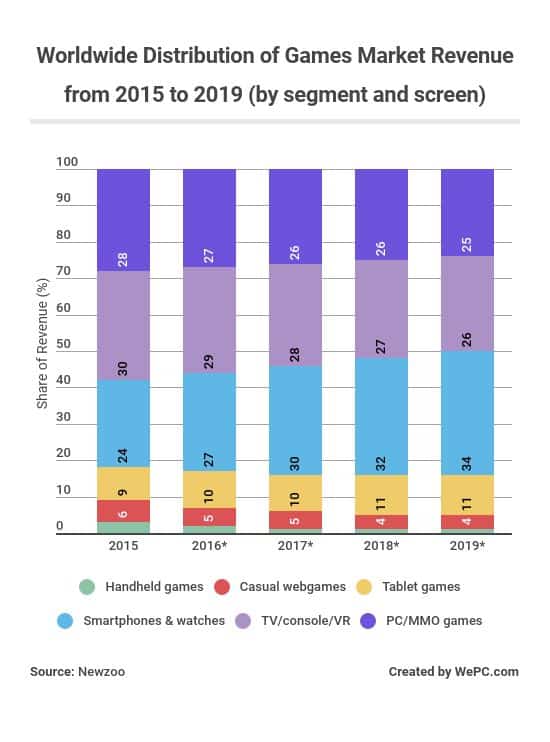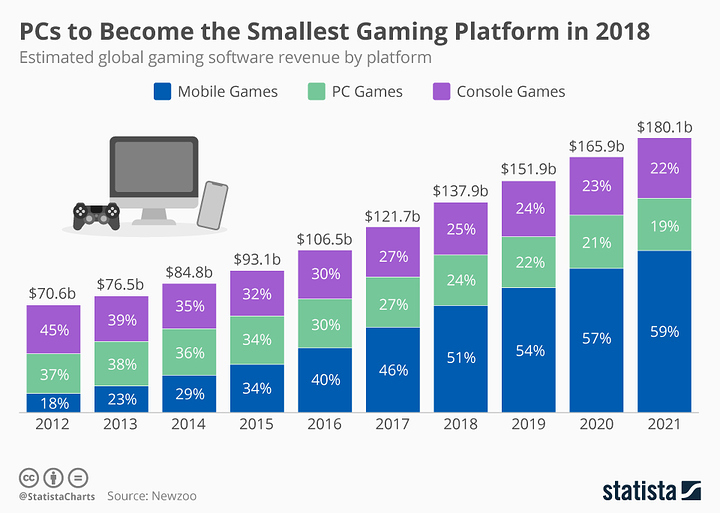If you’re old enough you’ll remember a time when nearly everything on a computer was connected via daughterboards (aka expansion cards). Support for storage, display, networking, sound — nearly everything.
One-by-one that circuitry has been miniaturised and optimised to the point where it can (and has) been moved from the daughterboards to the motherboard. Talented engineers made motherboard-hosted storage, networking and sound circuitry ‘good enough’ and so that’s where it now resides (for ‘normal’ users).
Pretty-much the only holdout — the only thing that people still stick into an expansion slot — is graphics. (Sure, there are some edge cases, but we’re not talking about those.)
Integrated graphics have been around for a while, and dominate the government, corporate and education sectors. Integrated graphics are ‘good enough’ to do what >90% of the planet needs their ‘computer’ to do (>99% if you count phones and tablets as computers).
The key to understanding the future of the PC gaming form factor is realising that PC gaming — in its entirety — is now ‘fringe’. We constitute a small fraction of the ‘gaming’ ecosphere, and that fraction is getting smaller every single year (even though in absolute numbers it may be holding roughly level, or even increasing a tiny bit — depending on which reports you read).
The reason that PC gaming is stagnating/dying is because the desktop itself is stagnating/dying. Here’s a summary of Apple’s desktop revenues (as a fraction of operations):
2001: 51.86%
2002: 49.25%
2003: 39.87%
2004: 28.66%
2005: 24.66%
2006: 17.18%
2007: 16.37%
2008: 14.99%
2009: 10.08%
2010: 9.51%
2011: 5.95%
2012: 3.84%
2013+ figures were so low that Apple stopped reporting them and merged the desktop and laptop categories together in their financial reports under the single heading (‘Mac’).
Even though Apple isn’t the first company that comes to mind when the word ‘gaming’ is used (by PC gamers), that view is dated (iOS gaming is huge). The point is that the PC form factor itself is in decline (as a fraction) everywhere.
So, if ‘desktop’ is declining, and ‘mobile’ is growing, then where does an increasing fraction of R&D investment go for developing new graphics? Towards miniaturisation and integration, of course. There’s less and less reason to invest money into building foot-long dGPUs with obscene power requirements when the majority of your customer’s ‘computers’ aren’t even that long and run on batteries.
Whether the graphics circuitry is a separate chip on the motherboard, or integrated into the CPU, doesn’t really matter. The point is that it won’t be on a card plugged into a PCIe slot.
We already have mini-ITX motherboards with only one PCIe slot. When that slot is no-longer required because ‘onboard graphics are good enough’ then what do we have left? Single-board computers. You don’t need an EATX tower to house one of those puppies.
The other thing to factor in is the software. When a large and increasing fraction of the people that play your games are on mobile, and a small and decreasing fraction of the people that play your games are on desktop, then it makes rational, economic sense to develop for mobile first and foremost. That means that new games will be increasingly designed to run within the constraints of the dominant platform.
We’ve already experienced a decade and a half of many PC game franchises being retarded in their development because of console limitations. Now that mobile is dominating as the gaming platform of choice, PC games will be retarded in their development due to mobile limitations as well. Cross-platform game development engines (e.g. Unity) ultimately pressure developers to produce games for the lowest common denominator. That means mobile graphics limitations will increasingly set the ‘high bar’ for PC games.
Consoles locked in an entire generation of games at 1920x1080 resolution. Mobiles will do something similar. With such low resolutions to cater for, the need for powerful desktop graphics evaporates.
So, in summary, the ‘glory’ days of PC gaming are over. Gamers have gone mobile. Graphics R&D investment is flowing increasingly towards solutions that work for the mobile market. New games are increasingly constrained by mobile resource limits. The ‘need’ for powerful dGPUs is evaporating. The ‘onboarding’ of graphics is already well underway, and is a trend that cannot be stopped. The number of PCIe slots you will see on motherboards will trend towards zero. Single-board computers are the inevitable future. Case form factors will follow.
I can’t say I particularly like what is happening, but mass-market-driven trends don’t care about my personal preferences…

 and effectively off-load that processing to the end user’s brain.
and effectively off-load that processing to the end user’s brain.

